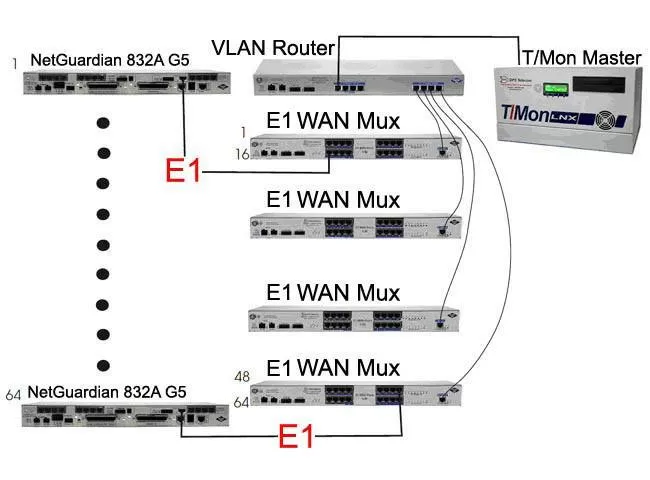Check out our White Paper Series!
A complete library of helpful advice and survival guides for every aspect of system monitoring and control.
1-800-693-0351
Have a specific question? Ask our team of expert engineers and get a specific answer!
Sign up for the next DPS Factory Training!

Whether you're new to our equipment or you've used it for years, DPS factory training is the best way to get more from your monitoring.
Reserve Your Seat TodayThe European Conference of Postal and Telecommunications Administrations (CEPT) originally standardized the E-carrier system. They developed the system in order to provide an industrial standard for digital transmissions of voice and data. Widely adopted by global telecommunications services, this E-Carrier system revised and improved the earlier American T-carrier technology. The International Telecommunication Union Telecommunication Standardization Sector (ITU-T) has now adopted the system for its reliability and cost-effectiveness.
Functionally similar to the method used in the United States, E-Carrier systems allow for rapid transmission of data over a wireline network. These systems have been pivotal for long-distance communication and the evolution of modern internet services.
An E1 link operates over two separate sets of wires. The two sets of wires are usually an Unshielded twisted pair (balanced cable) or a coaxial (unbalanced cable). A nominal electrical signal is encoded with pulses using a method avoiding long periods without polarity changes.
The line data rate is split into 32 timeslots, each being allocated 8 bits in turn. Thus each timeslot sends and receives an 8-bit PCM sample.
The samples are usually encoded according to A-law algorithm, 8000 times per second. This is ideal for telephone calls where the voice is sampled at that data rate and reconstructed at the other end. The timeslots are numbered from 0 to 31. Such encoding efficiency ensures high-quality voice transmission for telecommunications services across a wide array of networks.
This standard in communications is now widely used in almost all countries outside the US, Canada, and Japan. The ability to integrate with fiber optic cable systems makes it a preferred choice for bridging legacy and modern infrastructures.

If you work in telecom in the United States, you're probably familiar with T1. E1 is very similar, in that it's just a data connection. You can use it to send data of various types. This flexibility makes it indispensable for internet service providers managing diverse network needs.
One potential problem is that E1 is not standard IP LAN. This creates a need for translation equipment that "breaks out" LAN at a remote location that needs it.
The demand for compatibility between legacy systems and modern infrastructure continues to grow as networks evolve. While E1 has its challenges, legacy compatibility is where E1 systems shine. E1 offers a flexible solution to bridge traditional telephony with digital IP networks. By integrating fiber optic cables, these systems ensure reliable data transfer over long distances.
Many organizations still rely on legacy equipment that are crucial for operations but incompatible with IP networks. Replacing these systems entirely can be incredibly expensive and time-consuming. E1 links provide an efficient middle ground, allowing data and voice transmission without the need for immediate infrastructure overhauls. This is especially important for maintaining telecommunications services over expansive geographic areas.
E1 is not just a telephony solution. It supports a wide range of applications, including:
E1 networks offer redundancy and failover capabilities that protect against outages. With their durable design and proven reliability, they are ideal for mission-critical operations. When paired with advanced monitoring solutions like the T/Mon or NetGuardian RTUs, E1 networks can achieve near 100% uptime. This minimizes your downtime risks.
Transitioning to all-IP networks doesn't mean abandoning E1. Solutions like E1 adapters and SNMP-enabled devices make sure E1 systems remain relevant. To do so, they enable integration with IP-based infrastructure. This allows network operators to incrementally modernize their systems while leveraging the strengths of E1 connectivity.
NGCP's new overarching monitoring system, built around E1, is composed of E1-capable NetGuardian RTUs, E1 WAN muxes, VLAN routers, and a T/Mon LNX master station. It enables remote monitoring and diagnostics for equipment that was formerly managed with many disconnected systems. Full E1 case study...
NGCP was able to pull off this level of integration by working with a manufacturer who was capable of implementing custom functions (ex. E1 connectivity) into an already-proven RTU design. They also worked with a local rep in the Philippines to make sure they had a smooth deployment. Their rep, Okuda Sangyo Philippines, had previously attended factory training at DPS Telecom headquarters. This gave them the confidence to leverage the DPS philosophy of perfect-fit customization to develop the exact E1-based monitoring system that they needed.
Developing a custom product offered another advantage for NGCP: they knew that their future plans could be accommodated. When you buy off-the-shelf equipment and integrate it yourself, you are effectively becoming your own systems integrator. Only you will be able to support it, because no vendor is aware of what you're doing. One of your parts can be discontinued tomorrow, and you'll have to rework your design.
Working with a manufacturer who custom-tailors a device for you means that you'll get a manual. You'll get tech support. You'll get guaranteed compatibility with future deployments.
The Philippines is a complex place for a power utility to operate. There are over 7000 islands in the country. With such demanding circumstances, the team of NGCP engineers are sure to encounter unexpected and unusual requirements as they continue their rollout during the next several years. Having worked with a manufacturer who will make changes, they have a partner to help them easily navigate future scenarios.
NGCP purchased and rolled out a special build of the NetGuardian 832A that included new E1 functionality. With this modification in place, NGCP was able to utilize all of the 832A's standard features at their E1 locations. These features include: